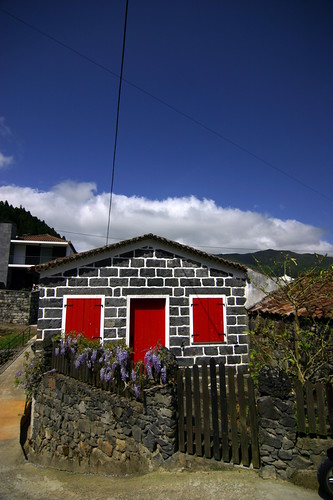The date of the discovery of Graciosa is doubtful, it is probable that it has been discover by sailors from the neighboring island of Terceira. It´s known only that was conquered by the order of the Infante Don Enrique, and in the middle of XVth century already were in it colonizing, being a pioneer Vasco Gil Sodré, of Montemor-o-Velho, with his family and his servants, he constructed his house in the same place where Carapacho settle. In spite of the formalities done by Sodré to receive the donation of the island, the Capitanería of the north part of Graciosa was granted to Pedro Correia da Cunha, brother-in-law of Christopher Colón, and the southern part to Duarte de Barreto.
The increase of the population - according to some historians came from Beiras and Minho and also Flanders-, as well as the prosperity of the island, makes Santa Cruz to receive the letter of burgo in 1486; while Praia received this distinction in 1546. The names of the big families that contributed to the accession and the growth of the island t are still today in the island.
Since XVIth century dedicated to the agriculture and to the grapevine, Graciosa exports, wheat, chicory, wine and brandy. With agricultural economy predominance, it made all its trade with Terceira that had a port frequented by ships of strong tonnage and was the economic and administrative center.
Graciosa suffered numerous assaults and corsairs' plunders during the XVIIIth century, but also historical personalities have visited it throughout centuries. The first one was Father António Vieira that, in 1654, after the shipwreck of the ship that was transporting him to Lisboa, near the island of Curved, was gathered by a Dutch corsair who took him to Graciosa, where he remained for two months. Later came the French writer Chateaubriand, who did a stop in the island during his escape to America in the time of the French Revolution, and he refers in some of his works his time in Graciosa.
The poet Almeida Garett resided also in Graciosa in 1814, when he was 15 years, after a visit to his uncle judge of the King; he wrote some texts that prove his talent. Finally, in 1879, came the Prince Alberto of Monaco to the Island to make his acquaintances works of hydrography and study of marine life.
Beign an island dedicated to the agriculture, the cattle and the production of milk, Graciosa keeps its characteristics of rural and calm island, and taking part of the progress of Azores.
The increase of the population - according to some historians came from Beiras and Minho and also Flanders-, as well as the prosperity of the island, makes Santa Cruz to receive the letter of burgo in 1486; while Praia received this distinction in 1546. The names of the big families that contributed to the accession and the growth of the island t are still today in the island.
Since XVIth century dedicated to the agriculture and to the grapevine, Graciosa exports, wheat, chicory, wine and brandy. With agricultural economy predominance, it made all its trade with Terceira that had a port frequented by ships of strong tonnage and was the economic and administrative center.
Graciosa suffered numerous assaults and corsairs' plunders during the XVIIIth century, but also historical personalities have visited it throughout centuries. The first one was Father António Vieira that, in 1654, after the shipwreck of the ship that was transporting him to Lisboa, near the island of Curved, was gathered by a Dutch corsair who took him to Graciosa, where he remained for two months. Later came the French writer Chateaubriand, who did a stop in the island during his escape to America in the time of the French Revolution, and he refers in some of his works his time in Graciosa.
The poet Almeida Garett resided also in Graciosa in 1814, when he was 15 years, after a visit to his uncle judge of the King; he wrote some texts that prove his talent. Finally, in 1879, came the Prince Alberto of Monaco to the Island to make his acquaintances works of hydrography and study of marine life.
Beign an island dedicated to the agriculture, the cattle and the production of milk, Graciosa keeps its characteristics of rural and calm island, and taking part of the progress of Azores.




No comments:
Post a Comment